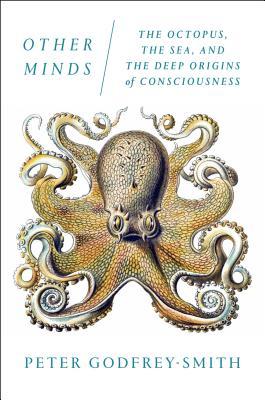This post is a continuation of my topic yesterday on “What Do Animals Think & Feel?“
 Regarding the implications of common ancestry and the tree of life, the best book I have read recently is Other Minds: The Octopus, the Sea, and the Deep Origins of Consciousness (Farrar, Straus and Giroux: 2016) by Peter Godfrey-Smith, a philosophy professor at the City University of New York. Although we only have to go back six million years to find the common ancestor of a human and a chimpanzee, we have to go back 600 million years to find the last common ancestors of humans and octopuses. As best we can tell, that last common ancestor of humans and octopuses looked something like a “small, flattened worm….just millimeters long” swimming in the ocean with “simple eyes, or at least light-sensitive patches…” (Godfrey-Smith 5). And over time, as members of this common ancestor reproduced, evolution happened
Regarding the implications of common ancestry and the tree of life, the best book I have read recently is Other Minds: The Octopus, the Sea, and the Deep Origins of Consciousness (Farrar, Straus and Giroux: 2016) by Peter Godfrey-Smith, a philosophy professor at the City University of New York. Although we only have to go back six million years to find the common ancestor of a human and a chimpanzee, we have to go back 600 million years to find the last common ancestors of humans and octopuses. As best we can tell, that last common ancestor of humans and octopuses looked something like a “small, flattened worm….just millimeters long” swimming in the ocean with “simple eyes, or at least light-sensitive patches…” (Godfrey-Smith 5). And over time, as members of this common ancestor reproduced, evolution happened
through an accumulation of happenstance changes…. And before long we are looking not at two collections of worms, but at two enormous branches of the evolutionary tree. One path forward…leads to vertebrates…and within vertebrates, to mammals and eventually humans. The other path leads to a great range of invertebrate species, including crabs and bees and their relatives, many kinds of worms, and also the mollusks, the group that includes clams, oysters, and snails (Godfrey-Smith 9).
And here’s where it gets really interesting. On that branch that leads not to us humans, but to octopuses, “most of the animals are fairly small…except for cephalopods.” Of particular interest are octopuses, cuttlefish, and squid, who all have “large and complex nervous systems” (Godfrey-Smith 4-5). “Cephalopods are an island of mental complexity in the sea of invertebrate animals.” And from the perspective of the tree of life in which we split from them 600 million years ago, the most recent common ancestor of humans and octopuses was so simple and lies so far back [those “small, flattened worms….just millimeters long” swimming in the ocean with “simple eyes, or at least light-sensitive patches…”] that
cephalopods are an independent experiment in the evolution of large brains and complex behavior. If we can make contact with cephalopods as sentient beings, it is not because of a shared history, not because of kinship, but because evolution built minds twice over. This is probably the closest we will come to meeting an intelligent alien (Godfrey-Smith 9).
All these claims, of course, raise a lot of questions about definitions.
When we talk about what animals think and feel, the word consciousness is about awareness. As far as I know, my dining room table is not conscious. I could chop it down or burn it, and it would make no difference to the table. If you remember the earlier Darwin quote about plants, then maybe the tree it came from was aware in some extremely basic sense of the word—but let’s set that aside for a future exploration about trees, since our current focus is on animals. One helpful definition of consciousness comes from Christof Koch, head of the Allen Institute for Brain Science in Seattle:
-
Consciousness is the thing that feels like something…. Cut your leg, that’s physical. If the cut hurts, you’re conscious.
-
The part of you that knows that the cut hurts, that feels and thinks, is your mind.
-
The ability to feel sensations is called sentience…. Under general anesthesia we remain very much alive though not conscious. And during sleep our unconscious brains are working hard, cleansing, sorting, rejuvenating. (Safina 21)
So how do we begin to map out the spectrum of sentience about what animals think and feel?
We still have a lot to learn, but science has also learned an incredible amount in the past century alone:
- “The simple fact that chickens establish a ‘pecking order’ was not formally recognized until the 1920s.”
- “Also in the 1920s, Margaret Morse Nice first discovered that songbirds defend territories—and that’s one of the most basic reasons they sing.”
- In 1973, three scientists shared a Nobel Prize for their studies of “honeybee dance-language, fish courtship, and how baby geese ‘imprint’ on the first moving object they see.” (Safina 25-26)
- “Conventional wisdom holds that only humans can consciously plan. But when jays [the name of several species of medium-sized birds] store perishable foods, they use up the perishable food stashes first.” (Safina 260)
- And generally “The most startling finding in recent work on animal intelligence is how smart some birds are, especially parrots and crows.” (Godfrey-Smith 50)
- Similarly, “Chickens exist in stable social groups. They can recognize each other by their facial features. They have 24 distinct cries that communicate information to one another, including separate alarm calls” (Bekoff and Pierce 34-35).
- Gorillas are one among many examples of animals who use forms of tools. Gorillas “test the depth of marsh water with sticks, use staves to lean out over water, and move logs to make bridges over swampy places…. Capuchin monkeys transport heavy stones to nut-tracking sites, choosing those of appropriate size as anvils and as hammers” (Safina 194-198).
- Octopuses “can learn to navigate simple mazes. They can use visual cues to determine which of two possible environments they have been placed in, and then take the correct route to a goal for that environment. They can learn to unscrew jars to obtain the food inside.” (Godfrey-Smith 52).
- Octopuses can also “recognize and behave differently toward individual human keepers “even when the humans are wearing identical uniforms. Similarly, a cuttlefish at Dalhousie University “reliably squirted streams of water at all new visitors to the lab, and not at people who were often around” (Godfrey-Smith 56).
- There are many recorded instances of grief behavior among elephants (Safina 68-69).
These are only a few among many other examples of what science is showing us about the spectrum of thinking and feeling within the Animal Kingdom of which we are a part.
And to make connections about how capacities to think and feel relate to the universal tree of life and evolution through common ancestry,
Brain scans show that core emotions of sadness, happiness, rate, fear, and motivational feeling of hunger and thirst, are generated in deep and very ancient circuits of the brain…. The genes that direct our own bodies to create the mood-making brain hormones oxytocin and vasopressin, for instance, date back at least seven hundred million years… [which is older than the last common ancestor of humans and octopuses]. Oxytocin drives bonding…and it makes animal species act social or sexual. Block the hormone; many mammals and birds lose interest in socializing, pairing, nesting, and contact…. Given a sniff of oxytocin, human fathers get more playful with their babies, increase eye-to-eye gazing, and show greater interest in the child.
So what does all that mean for how animals think and feel? The ecologist Carl Safina likes to sum it up this way: “Your dog really does love you. Part of the reason is: because you are kind. If you were abusive, your dog would fear you. And they might still love you, out of duty or need—not so different from many people trapped in abusive relationships” (Safina 238). For me, this evolutionary, tree of life, universal common ancestor view of the world makes me feel deeply connected to what the Unitarian Universalist Seventh Principle calls the “interdependent web of all existence.”
Along these lines, I invite you to hear a final quote from Safina about how he has come to think about the tree of life:
The different species are like people who knew each other in high school but have since gone on to different lives and livelihoods. Lots in common. Common roots. A bond, perhaps neglected…. Lots of shared history. And between first breath and final gasp, we endeavor toward a common quest: to love, to raise our young, to find space enough for our lives, to survive the confronting dangers, to do what it takes, to the best of our abilities, to live out the mystery and opportunity of finding ourselves somehow in existence.
We are not all equal. There are real differences, but these differences are on a spectrum of degree rather than kind. So may we each do what we can within our spheres of influence to decrease suffering and cruelty and to increase freedom and compassion for all sentient beings. In the words of the Buddhist “loving-kindness” meditation:
May all sentient beings be filled with loving-kindness
May all sentient beings be well.
May all sentient beings be peaceful and at ease.
May all sentient beings be free.
The Rev. Dr. Carl Gregg is a certified spiritual director, a D.Min. graduate of San Francisco Theological Seminary, and the minister of the Unitarian Universalist Congregation of Frederick, Maryland. Follow him on Facebook (facebook.com/carlgregg) and Twitter (@carlgregg).
Learn more about Unitarian Universalism: http://www.uua.org/beliefs/principles
















